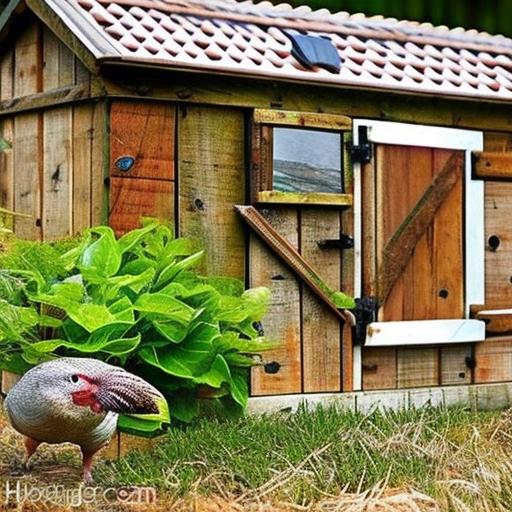Ventilation is a crucial factor to consider when designing a chicken coop, as it plays a vital role in maintaining the health and well-being of your feathered friends. But just how much ventilation does a chicken coop really need? In this article, we will explore the importance of proper ventilation in a chicken coop and provide guidelines on how to ensure your coop is well-ventilated for happy and healthy hens.
Table of Contents
Importance of Proper Ventilation in a Chicken Coop
Proper ventilation in a chicken coop is crucial for the health and well-being of your feathered friends.without adequate ventilation, ammonia and other harmful gases can build up, leading to respiratory issues and even death in extreme cases. Additionally, poor ventilation can also result in high humidity levels, which can create the perfect surroundings for mold and mildew to thrive.
So, how much ventilation does a chicken coop need? The general rule of thumb is to provide at least 1 square foot of ventilation for every 10 square feet of floor space in the coop. This can be achieved through a combination of windows, vents, and openings near the roof to allow for proper air circulation. By ensuring that your chicken coop has adequate ventilation, you can help keep your flock happy, healthy, and productive.
Key Factors to Consider when Determining Ventilation Needs
When determining the ventilation needs for a chicken coop, it is indeed essential to consider several key factors to ensure the health and well-being of the chickens. One vital factor to consider is the size of the coop. A larger coop will require more ventilation to ensure proper air circulation and prevent the buildup of harmful gases. Additionally, the number of chickens in the coop will also impact the ventilation requirements, as more chickens will produce more moisture and ammonia that need to be properly ventilated.
Another key factor to consider is the location of the coop. A coop that is located in a humid or hot climate will require more ventilation to prevent overheating and moisture buildup. Proper ventilation can also help control odors and decrease the likelihood of respiratory issues in the chickens. It is important to strike a balance between providing enough ventilation to maintain air quality while also protecting the chickens from drafts and extreme temperatures.
Optimal Ventilation Strategies for Different climates
When it comes to providing optimal ventilation for chicken coops, the amount of air flow required can vary based on the climate in which the coop is located. In warmer climates, it is indeed critically important to ensure that there is adequate ventilation to prevent the buildup of heat and moisture, which can lead to health issues for the chickens. Conversely, in colder climates, excessive ventilation can result in drafts that can make the coop too cold for the chickens.
One effective ventilation strategy for chicken coops in warmer climates is to incorporate natural ventilation by providing openings near the roof or eaves of the coop to allow hot air to escape. Additionally, installing adjustable vents can definitely help regulate airflow based on the weather conditions. In colder climates,insulating walls can help retain heat while still allowing for proper ventilation. it is indeed critically important to monitor the temperature and humidity levels inside the coop to ensure that the ventilation is adequate for the chickens’ health and well-being.
Common Mistakes to Avoid when Ventilating a Chicken Coop
When it comes to ventilating a chicken coop, there are several common mistakes that new chicken owners make. One mistake is not providing enough ventilation for the coop. Proper ventilation is crucial for the health and well-being of your chickens, as it helps to remove excess moisture, ammonia, and other harmful gases from the coop.
Another mistake to avoid is blocking off ventilation openings in an attempt to keep the coop warmer in the winter. While it’s important to keep your chickens warm during cold weather, it’s equally important to ensure that they have enough fresh air to breathe. Blocking off ventilation can lead to poor air quality in the coop, which can cause respiratory issues for your chickens.It’s important to strike a balance between keeping your chickens warm and providing adequate ventilation.
Q&A
Q: How much ventilation does a chicken coop need?
A: Good ventilation in a chicken coop is essential for the health and well-being of your flock. ideally, you should provide at least one square foot of ventilation per bird to ensure proper air circulation.
Q: Why is ventilation important in a chicken coop?
A: Ventilation helps to remove excess moisture, ammonia, and other harmful gases from the coop, which can lead to respiratory issues and other health problems for the chickens. It also helps to regulate the temperature inside the coop, especially in hot weather.
Q: What are some signs that a chicken coop is not properly ventilated?
A: Signs of poor ventilation in a chicken coop include a strong ammonia smell,condensation on the walls and windows,and an increase in respiratory problems among the flock. In extreme cases, you may also notice a build-up of mold and mildew.
Q: How can I improve ventilation in my chicken coop?
A: to improve ventilation in your chicken coop, make sure there are plenty of openings for fresh air to enter and stale air to exit. This can include windows, vents, or even a fan. It’s also critically important to keep bedding clean and dry, as wet bedding can contribute to poor air quality.
Q: Are there any risks associated with too much ventilation?
A: While good ventilation is important, too much ventilation can also be harmful to your chickens, especially in colder weather. Make sure to strike a balance between providing enough fresh air and protecting your flock from drafts and extreme temperatures.
In Retrospect
proper ventilation is essential for the health and well-being of your chickens. By providing adequate airflow in the coop, you can help prevent issues such as respiratory problems, mold growth, and excessive humidity. Remember to consider the size of your coop, the number of chickens housed inside, and the climate of your area when determining the amount of ventilation needed. By taking these factors into account, you can create a comfortable and safe living environment for your feathered friends. So, don’t let your coop become a stuffy and stagnant space – let the fresh air flow in!
Meet Walter, the feathered-friend fanatic of Florida! Nestled in the sunshine state, Walter struts through life with his feathered companions, clucking his way to happiness. With a coop that’s fancier than a five-star hotel, he’s the Don Juan of the chicken world. When he’s not teaching his hens to do the cha-cha, you’ll find him in a heated debate with his prized rooster, Sir Clucks-a-Lot. Walter’s poultry passion is no yolk; he’s the sunny-side-up guy you never knew you needed in your flock of friends!






